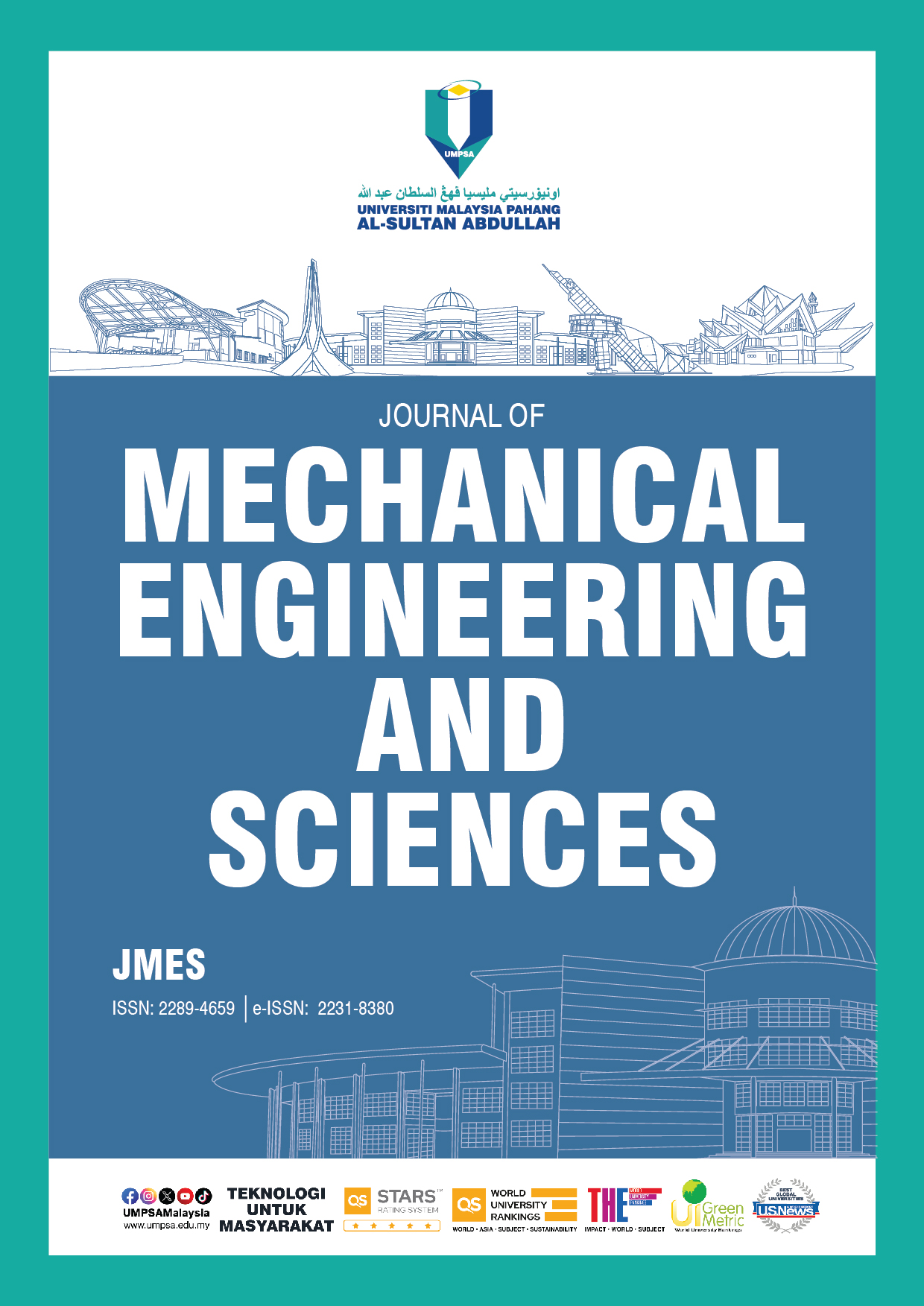The effect of Aegle marmelos shell particles volume fraction on hardness, toughness, and wear rate of epoxy matrix composites as motorcycle brake pads
DOI:
https://doi.org/10.15282/jmes.17.1.2023.4.0738Keywords:
Aegle marmelos shell particles , Hardness, Motorcycle brake pads, Toughness, Wear rateAbstract
The utilization of Aegle marmelos shell particles is not optimal yet. Composite brake pads are currently being developed because they are eco-friendly and heat resistant compared to non-asbestos brake pads. This research attempt to analyze the volume fraction of Aegle marmelos shell particles on the measure of hardness, toughness, and wear of epoxy matrix composites as an alternative material for motorcycle brake pads. The design of this research uses a true experimental design with a posttest-only design type, there is an experimental group (composite) and a control group (Indoparts brand brake pads). The results show the most optimal measure is found in volume 30% with a hardness measure of 79.5 HRB, toughness 0.01312 J/mm2, wear 2.008 x 10-6 mm2/kg. It shows that the more particles volume, the composite strength will increase. This measure is closest to the measure of the Indoparts motorcycle brake pads. Therefore, Aegle marmelos shell particles composite can be recommended as an alternative material for motorcycle brake pads.
References
R. Vasquez and B. Farooq, “Multi-objective autonomous braking system using naturalistic dataset,” 2019 IEEE IntelligentTransportation Systems Conference ITSC 2019, pp. 4348–4353, 2019.
V. V. Kumar and S. S. Kumaran, “Friction material composite: Types of brake friction material formulations and effects of various ingredients on brake performance-a review,” Materials Research Express, vol. 6, no. 8, 2019.
P. Deepak, H. Sivaraman, R. Vimal, S. Badrinarayanan, and R. Vignesh Kumar, “Study of wear properties of Jute/Banana fibres reinforced molybdenum disulphide modified epoxy composites,” Materials Today: Proceedings,vol. 4, no. 2, pp. 2910–2919, 2017.
D. Shinde andK. N. Mistry, “Asbestos base and asbestos free brake lining materials: comparative study,” World Scientific News, vol. 61, no. 2, pp. 192-198, 2017.
B. Ergene and Ç. Bolat, "A review on the recent investigation trends in abrasive waterjet cutting and turning of hybrid composites," Sigma Journal of Engineering and Natural Sciences, vol. 37, no. 3, pp. 989-1016, 2019.
M. N. P. Sastry, K. D. Devi, andD. Bandhu, “Characterization Aegle marmelosfiber reinforced composite,” International Journal of Engineering Research, vol. 5, no. 2, pp. 345-349,2016.
J. Sahari, S. M. Sapuan, E. S. Zainudin, andM. A. Maleque, “Mechanical and thermal properties of environmentally friendly composites derived from sugar palm tree,” Materials Design, vol. 49, pp. 285-289, 2013.
C. Elanchezian, B. V. Ramnath, G. Ramakrishnan, M. Rajendrakumar, V. Naveenkumar, andM. Saravanakumar, “Review on mechanical properties of natural fiber composites,”Materials Today: Proceedings, vol. 5, no. 1, pp. 1785-1790, 2018.
L. Prasad, G. Singh, andM. Pokhriyal, “Acomparative study on physical and mechanical behaviour of functionally graded composite materials reinforced with natural fillers,” Advances in Materials & Processing: Challenges & Opportunities (AMPCO), vol. 5, no. 9, pp. 16990-16994, 2017.
O. Shakuntala, G. Raghavendra, andS. K. Acharya, “Characterization of wood apple shell particles,” Conference Proceedings of the Second International Conference on Recent Advances in Bioenergy Research, Springer Proceedings in Energy, pp. 139-146, 2018.
O. Gbadeyan,K. Kanny,andT. P. Mohan, “Influence of the multi-walled carbon nanotube and short carbon fibre composition on tribologicalproperties of epoxy composite,” Tribology-Materials, Surface & Interfaces,vol. 11 no. 2, pp. 1-7, 2017.
M. A. Maleque, A. Atiqah, R. J. Talib,andH. Zahurin, “New natural fibre reinforced aluminium compositefor automotive brake pad,” International Journal of Mechanical and Materials Engineering, vol. 5, no. 2, pp. 166-170, 2012.
K. Satikbašaet al., “Effect of steel family fibers on friction and stiction behavior of brake pads,”FME Transactions, vol. 47, no. 4, pp. 856-864, 2019.
S. Sathish,K. Kumaresan, L. Prabhu,andS. Gokulkumar, “Experimental investigation of mechanical and ftir analysis of flax fiber/epoxy composites incorporating sic, al2o3 and graphite,” Romanian Journal of Materials,vol. 48, no. 4, pp. 476-482, 2018.
K. Bhar, S. Mondal,and P. Suresh, “An eye-catching review of Aegle marmelos L. (golden apple),” Pharmacognosy Journal, vol. 11, no. 2, pp. 207-224, 2019.
S. Ojha, G. Raghavendra, and S.K. Acharya, “Acomparative investigation of bio-wastefiller (wood-apple coconut) reinforced polymer composite,”Polymer Composite,vol. 35, no. 1, pp. 180-185, 2014.
N. C. Sandeep, H. Raghavendra Rao, and K. Hemachandra Reddy, “Extraction and Characterization of Physicochemical and Tensile Properties of Aegle Marmelos fiber,” Materials Today: Proceedings, vol. 4, no. 2, pp. 3158–3165, 2017.
N. Saba et al., “Recent advances in epoxy resin, natural fiber-reinforced epoxy composite and their appllications,” Journal of Reinforced Plastics and Composite, vol. 35, no. 6, pp. 447-470, 2016.
C. Verma et al., “Epoxy resins as anticorrosive polymeric materials: A review,” Reactive and Functional Polymers, vol. 156, p. 104741, 2020.
R. Gottipatiand S. Mishra, “Preparation of microporous activated carbon from Aegle marmelos fruit shell by koh activation,” The Canadian Journal of Chemical Engineering,vol. 91, no. 7, pp. 1215-1222, 2013.
I. K. A. Atmika, I. D. G. A. Subagia, I. W. Surata, and I. N. Sutantra, “Hardness and wear rate of basalt/alumina/shellfish powder reinforced phenolic resin matrix hybrid composite brake lining pads,” IOP Conference Series: Materials Science and Engineering, vol. 539, no. 1, pp. 012012, 2019.
ASTM E18, Standard Test Methods for Rockwell Hardness of Metallic Materials, American Society for Testing and Materials, 2015.
ISO 179-1, Plastics–Determination of Charpy Impact Properties, International Organization for Standardization, Geneve: Switzerland, 2010.
Tokyo Testing Machine Mfg. Co., Ltd, Ogoshi High Speed Universal Wear Testing Machnine Instruction Manual. Manual Instruction Book, Japan.
S. Ojha,S.K. Acharya, andG. Raghavendra, “Mechanical properties of natural carbon black reinforced polymer composites,”Journal of Applied Polymer Science, vol. 132, no. 1, pp. 1-7, 2014.
R. O. Akaluzia et al., “Evaluation of the effect of reinforcement particle sizes on the impact and hardness properties of hardwood charcoal particulate-polyester resin composites,” Materials Today: Proceedings,vol. 38no. 2, pp. 570-577, 2021.
S. PujariandS. Srikiran, “Experimental investigations on wear properties of palm kernel reinforced composites for brake pad applications,” Defence Technology, vol. 15, no. 3, pp. 295-299, 2019.
R. Soundararajan, S. Karthik, and S. Sivaraman, “Automotive brake pad by using, functionally graded hybrid composites and their behaviour,” InternationalJournal ofMechanicalEngineeringand Technology, vol. 9, no. 9, pp. 318-328, 2019.
Y. Sukrawan, A. Hamdani, and S. A.Mardani, “Effect of bamboo weight faction on mechanical properties in non-asbestos composite of motorcycle brake pad,” Materials Physics and Mechanics, vol. 42, no. 3, pp. 367-372, 2019.
P. V. Arumugaet al., “Usage of industrial wastes as particulate composite for environment management: hardness, tensile andimpact studies,” Journal ofEnvironmental Chemical Engineering, vol. 5, no. 1, pp. 1289-1301, 2017.
V. V. Rampur, A. R. Banagar, U.L. Ganesh, C. V. Srinivas, andS.C. Reur, “Mechanical characterization of wood apple shell powder and coconut shell powder reinforced hybrid composite,” AIP Conference Proceedings, vol. 2247, no. 1, pp. 04001, 2020.
B. T. Mulyo and H. Yudiono, “Toughness analysis of pineapple leaves fiber composite as alternative material for SNI helmet,” Journal of Mechanical Engineering and Sciences, vol. 13, no. 4, pp. 5961-5972, 2019.
Z. Liao,N. Hua, W. Chen, Y. Huang,andT. Zhang, “Correlations between the wear resistance and properties of bulk metallic glasses,” Intermettalics,vol. 93, pp. 290-298, 2018.
Z. S. Kiran, V. S. Babu,and K. V. L. Soma Sekhar, “Study of the microhardness and erosive wear behavior of organo-modified nanoclay filled glass-epoxy composites and optimization,” Journal of Mechanical Engineering and Sciences,vol. 13, no. 2, pp. 4794-4815, 2019.
N. A. Ademohand A. I. Olabisi, “Development and evaluation of maize husks (asbestos-free) based braked,” Industrials Engineering Letters, vol. 5, no. 2, pp. 67-80, 2015.
M. Afolabi, O. K. Abubakre, S.A. Lawal,andA. Raji, “Experimental investigation of palm kernel shell and cow bone reinforced polymer composites for brake pad production,” International Journal of Chemistry and Material Research, vol. 3, no. 2, pp. 27-40,2015.
Sukanto, R. Soenoko, W. Suprapto, and Y. S. Irawan, “Characterization of aluminium matrix composite of Al-ZnSiFeCuMg alloy reinforced with silica sand tailings particles,” Journal of Mechanical Engineering and Sciences,vol. 14, no. 3, pp. 7094-7108, 2020.
Downloads
Published
Issue
Section
License
Copyright (c) 2023 Universiti Malaysia Pahang Publishing

This work is licensed under a Creative Commons Attribution 4.0 International License.






